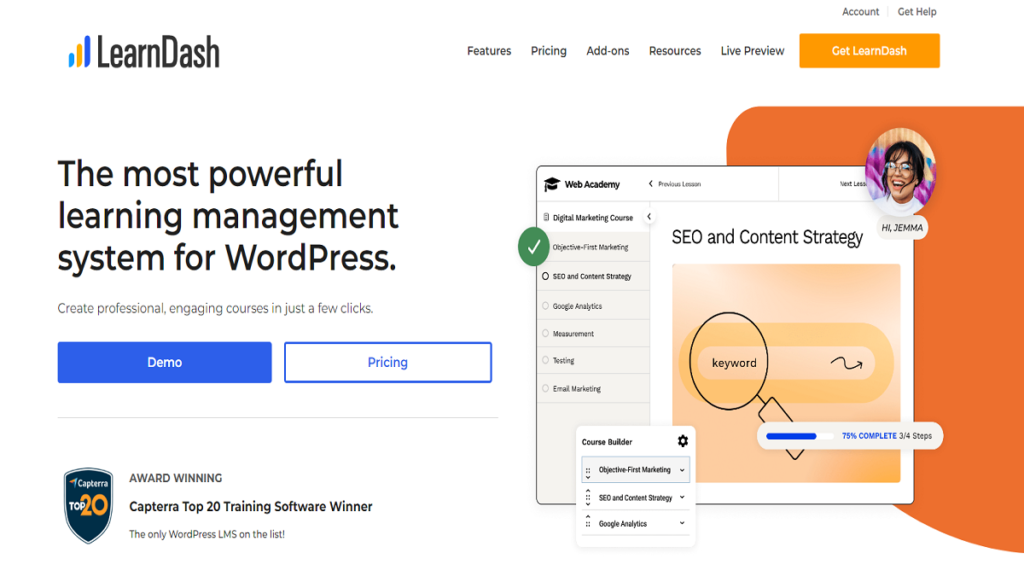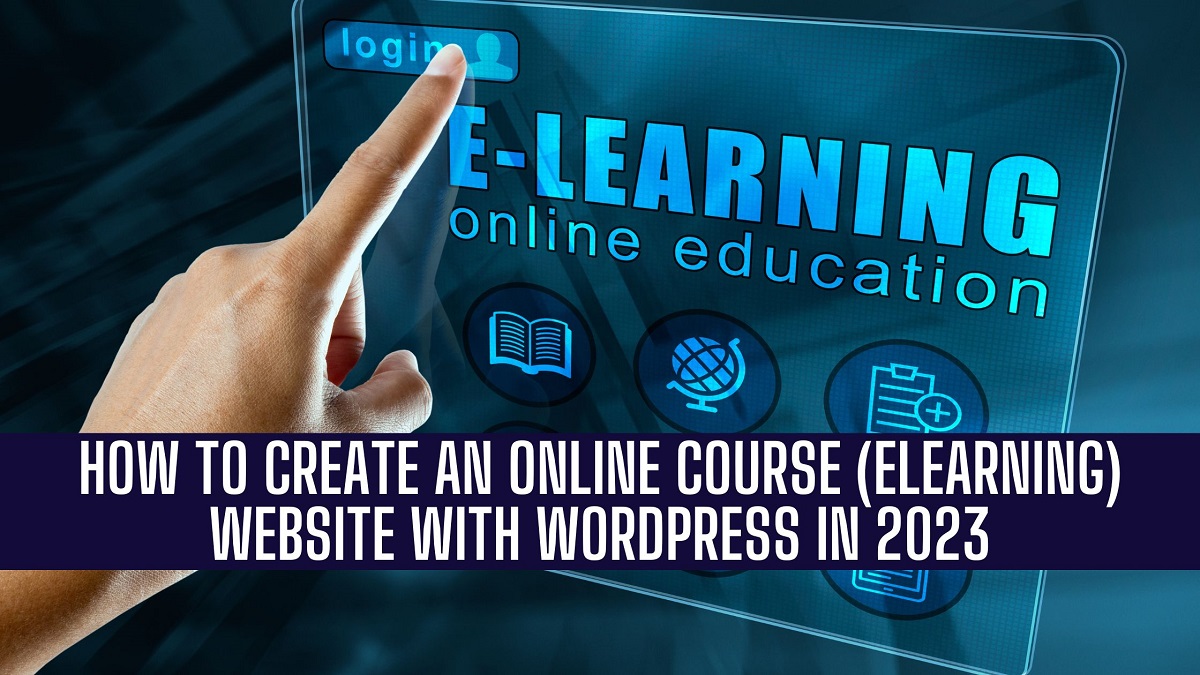Everything from studying martial arts to learning flutes to learning French to learning Python has an online course. If you give some thought to what it is you want to study, you will undoubtedly be able to locate an appropriate online course. There has recently been a dramatic increase in the demand for online education. They give a fantastic chance to improve one’s competence and develop one’s character and career without incurring a heavy financial burden.
Therefore, if you have expertise in a specific area, a target audience, and a desire to pass that knowledge on to others, there is no better time to launch your online course. Creating an online course is not difficult; it can be done with a few mouse clicks using WordPress and an appropriate LMS (Learning Management System). The LMS and other WordPress plugins, such as WooCommerce and BuddyPress, will handle all the other hassle-inducing tasks, such as managing content, students, payments, etc.
Table of Contents
What is LMS?
An LMS, or Learning Management System, is a standardized platform for providing access to educational content through virtual classes. It facilitates the development of a protected user interface for the distribution of online instruction. In addition to recording the results of tests and quizzes given to pupils, it also monitors their progress. Using a Learning Management System (LMS) facilitates the delivery of valuable resources to students.
What to look for in an LMS plugin?
All of the following features are standard in any reliable LMS plugin:
Building Courses
The WordPress LMS plugin should provide a solid framework for creating and publishing courses, including video, PDF, quizzes, reports, and other types of content.
Student Management
This function will facilitate keeping track of students’ information, including their courses, membership status, fees, etc.
Progress Reporting
Students’ motivation is boosted since their current standing in the course is made clear. It’s a crucial element in maintaining pupils’ interest.
Quizzes and examinations
Evaluation is done through tests and quizzes so that students can see where they are academically, establish future goals, and correct their weaknesses.
Digital Marketing tools
A robust learning management system will give you a digital marketing tool for promoting your courses, expanding your audience and generating more revenue.
Different plugin integrations
A WordPress site dedicated to selling courses requires plugins like bbPress and BuddyPress. They facilitate the development of online discussion groups and communities, providing an appropriate setting for social learning.
Badges and Certificates
Students’ spirits are lifted anytime they complete an assignment or an activity and receive a badge or award to show for it. These are great for bringing some life and excitement to a distance learning session.
Can an e-learning website generate income?
Definitely! As we’ve already shown, payment plugins like WooCommerce and Easy Digital Downloads work well with most LMS plugins.
You may use these plugins with any business model you desire, from one-time payments for courses to recurring payments for subscriptions. Once you know the basics of making an online course, you may adapt the process to suit various subjects.
Online teaching has become a lucrative career choice for many teachers. LearnDash is only one example of an LMS that is used by a wide variety of educational institutions.
Some of the best LMS plugin available on WordPress
Among the finest WordPress plugins for online learning management systems

What do you need to sell courses online?
- A niche for which you can develop a course.
- A domain name for the website.
- A WordPress hosting account with an SSL certificate.
- An LMS plugin.
- A good WordPress theme.
- Addons Integration to add more features to your platform.
Step 1: Domain Name and web hosting
Domain Name
Pick a domain name that is memorable, distinct and does justice to who you are. It is your official online resumé.
Web Hosting
Website hosting is where your courses and data will be kept safe and secure. Many companies offer web hosting services, including BlueHost, Hostinger, HostGator, and DreamHost.

You can only pick one. There are advantages to using each of the different hosting options. To set up Payment Gateway, you must acquire an SSL certificate.
Step 2: Installing WordPress
Numerous hosting providers provide WordPress-tailored hosting packages at reasonable prices. WordPress is free to download and use, but web hosting will cost you. Self-installation of WordPress is also possible via a straightforward guide.
After WordPress has been set up, we may continue to the next step.
Step 3: Choosing an e-learning theme
Both appearance and a streamlined user experience (UI) are greatly aided by themes (UI). Choosing a suitable theme is crucial when creating a professional website like Udemy or Coursera. A premium WordPress theme will provide us access to a wide variety of customization options, including but not limited to design, speed, navigation, user-friendly functionality, sidebar layouts, widgets, header styles, and more.

WordPress provides access to a wide variety of e-learning themes.
There are many great eLearning themes out there on the WordPress store, you can choose the one you like the best.
Step 4: Selecting a Learning Management System (LMS)
We’ve covered the available LMS plugins, so it’s time to pick one. Here, we’ll use LearnDash for future development because it’s well-regarded as a plugin and works well with various others.
Step 5: Importing demo and customization
Once a theme has been chosen, the next step is developing and personalizing the website by adding elements such as widgets, arranging the homepage, setting up menus, etc.
Nowadays, about every elearning theme has multiple demos. You can head start by importing the Demo Installer, which will provide you with all of the theme’s settings, widgets, pages, and more. All that is required of you is some minimal editing housekeeping. The advanced customization feature gives you even more room for individual expression.
Step 6: Include a Community With BuddyPress
Incorporate an In-Depth Community When individuals with similar interests and goals get together to share what they’ve learned, BuddyPress shines. For this reason, online instructors must establish a rapport with their students and assist them in resolving any issues they may have with the course.
The BuddyPress plugin makes it easy to set up various online communities with user profiles, discussion forums, and direct messaging among members. Connecting your instructors, students, and courses into a cohesive whole may improve the quality of education offered.
Step 7: Payment gateway setup and e-marketing
The most straightforward approach to doing business in cyberspace is installing payment gateways. LearnDash is compatible with plugins for the eCommerce platform WooCommerce, allowing you to easily set up payment processing and promote your business online with a wide range of e-marketing options.
If you’re planning on offering courses to businesses in quantity, you have a few options for how to do so.
Step 8: Creating student groups and discussion forums
To get the most out of their education, students need to engage in conversation with one another throughout the class. This may be accomplished rapidly by organizing students into topic-specific groups and online forums. The bbPress plugin with LearnDash’s wpForo makes it simple to set up discussion boards and keep an eye out for spam.
Step 9: Making Use of Gamification to Engage Students
To make tasks and achievements more fun, install the GamiPress plugin. It makes taking quizzes and exams more enjoyable, boosting the course’s popularity. It is compatible with most of the elearning themes.

Step 10: Adding useful and features with multiple Addons
Your website is now finished, and you may go live. You can take your website to the next level by incorporating additional features and functionality provided by several WordPress plugins.
The following are some examples of additional plugins designed for use with LearnDash sites:
LearnDash Notes is an add-on that allows users to make real-time notes on a wide range of subjects; these notes may then be shown on various profiles and pages utilizing shortcodes. In addition, it has many helpful features and allows for individualized administration.
WISDM Instructor Role
It enables the administrator to assign course administration duties to “Instructors” who can create, modify, manage, and grade students. By extension, you may turn your single-teacher website into a marketplace like Udemy or Coursera or even a website with several instructors. The details that instructors can submit here include their photo, bio, areas of specialty, degrees earned, courses they have designed, ratings, and other information. Profile pages help educators present themselves and give them credibility. Contact information can also be shared via the profile page.
LearnDash Dashboard
This LearnDash extension gives students and teachers a dashboard for organizing their work and coordinating with one another. It would help if you had the Reign LearnDash add-on to promote your courses, a must-have. Features like more widget choices, three distinct course layouts designed to keep students interested, and interaction with LearnDash’s BuddyPress are just the beginning.
Design Upgrade Pro & Quiz Customiser
It enables the administrator to assign course administration duties to “Instructors” who have the ability to create, modify, manage, and grade students. By extension, you may turn your single-teacher website into a marketplace like Udemy or Coursera or even a website with several instructors. The details that instructors can submit here include their photo, bio, areas of specialty, degrees earned, courses they have designed, ratings, and other information. Profile pages help educators present themselves and give them credibility. Contact information can also be shared via the profile page.
Here are few more LearnDash Add Ons you for to check out:
- Tin Canny LearnDash Reporting
- LearnDash Notifications
- WISDM Ratings, Reviews, and Feedback
- UnCanny Toolkit Pro
- WISDM Group Registration
Anyone with information to impart to the world would benefit greatly from creating an online educational website. The industry is expanding rapidly, making it one of the most dynamic in the world. Therefore, why delay? Make your student network and online course website to join this multibillion-dollar business.
